Discovering Specialty Bundt Cake Pans: The Ultimate Guide
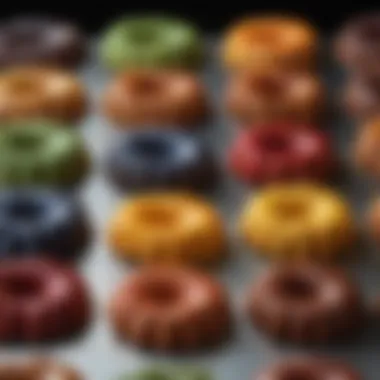
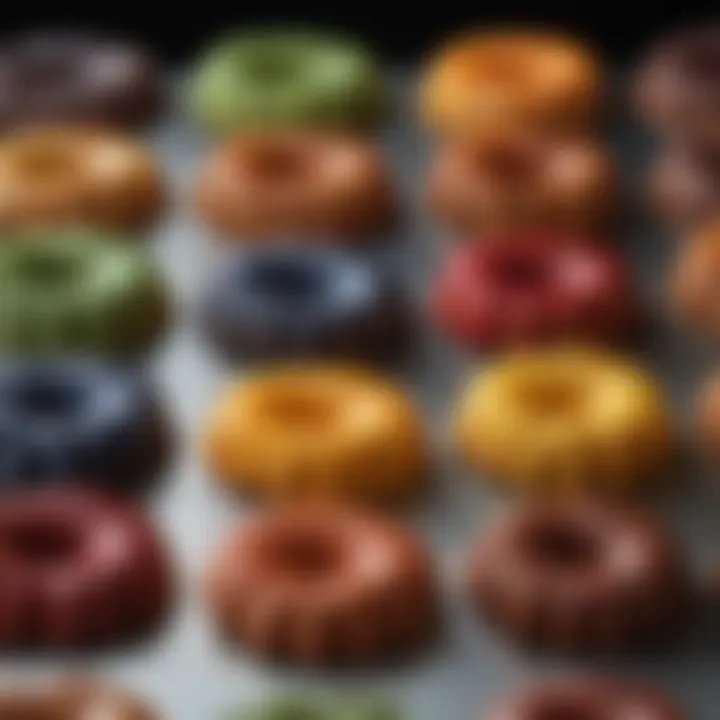
Intro
In the world of baking, bundt cakes hold a special allure. Their distinct shapes and elegant appearance set them apart from traditional cakes. Specialty bundt cake pans enhance this experience, offering various designs and materials that elevate the baking process. Understanding the nuances of these pans is vital for home bakers aiming to create stunning desserts.
This guide piece collaborates an in-depth look at those intricacies, covering how specialty bundt cake pans function. It highlights key features, benefits, care techniques, and even presents creative recipe options that can be made using these pans. As one digs deeper, each section reveals essential insights that guide potential buyers or users in making informed decisions surrounding their culinary ventures.
This resource aims not only to inform but to also inspire chefs and home bakers alike, aiding them in achieving impressive results with their specialty equipment.
Recipe Highlight
Introducing a delectable Honey Almond Bundt Cake: a perfect dessert that combines the allure of honey with the nutty essence of almonds.
Essential Ingredients
- 2 cups all-purpose flour
- 1 cup granulated sugar
- 1 cup unsalted butter
- 3 large eggs
- 1/2 cup honey
- 1 cup ivory or slivered almonds
- 1 tsp vanilla extract
- 1 tsp baking powder
- 1/2 tsp salt
Estimated Time
Total preparation and baking time: 1 hour.
Yield
This recipe serves approximately 8 slices.
Step-by-Step Instructions
- Preheat your oven to 350°F (175°C).
- Grease your specialty bundt pan using a non-stick spray or butter to ensure easy release.
- In a mixing bowl, combine the granulated sugar and softened butter, mixing until it's light and fluffy.
- Add in the eggs one at a time, followed by the honey and vanilla extract, continuing to mix until incorporated.
- Sift together all-purpose flour, baking powder, and salt in a separate bowl. Gradually add this dry mixture into the wet ingredients, stirring until just combined. It's okay to see some lumps.
- Fold in the almonds gently, being careful not to overmix.
- Pour the batter into the prepared bundt pan and smooth the top with a spatula.
- Bake for 35-40 minutes or until a toothpick comes out clean.
- Let the cake cool completely in the pan before inverting it onto a wire rack.
Incorporating simple techniques, like folding in the almonds, ensures the texture remains flawless.
Variations and Substitutions
- Instead of honey, you can use maple syrup for a refined flavor twist.
- Almonds can be replaced with pecans or walnuts for different textural adjustments.
- Another option is to add zest of lemon for a refreshing note.
To pair this cake, consider serving it with vanilla ice cream or fresh fruit for added dimension.
Time-Saving Cooking Tips
Preparing the kitchen will save you much time while baking. Follow these small strategies:
- Begin by measuring out all ingredients ahead of time.
- Utilize gathering gadgets like a silicone spatula for speeding up the mixing process.
- To save on clean-up time, use one bowl for both dry and wet mixtures as much as possible.
Preparing individual components can lead to simpler meal preps for busy weekdays as well.
Nutritional Information
For one slice:
- Approximate calories: 295
- Sugars: 20g, Proteins: 3g
- Health Benefits: Almonds provide healthy fats and fibers while honey offers natural sweetness and antioxidants.
It’s suitable for recreational bakers, with serving sizes adaptable for followers of various dietary preferences such as gluten-free options when needed.
Specialty bundt cake pans not only enhance presentation in the baking activity. They can greatly expand one's culinary capabilities by allowing a wide range of innovative recipes.
Prolusion to Specialty Bundt Cake Pans
Bundt cake pans have a special place in the world of baking, combining form and function in a way that enhances both preparation and presentation. Specialty Bundt cake pans take this concept further, offering unique shapes and designs that elevate homemade desserts. Understanding these pans is essential for anyone seeking to impress with their baking skills.
Specialty Bundt cake pans provide several advantages. First, they allow for an aesthetically pleasing presentation directly from the oven. The intricate designs create a visually appealing centerpiece that requires no additional decoration for a festive occasion.
When choosing a bundt cake pan, various factors hold importance. From material considerations to nonstick options, each choice influences the baking process and results achieved. For instance, metal pans are often chosen for their excellent heat conduction minimizing baking times compared to silicone. Additionally, the design influences the cake's texture and the evenness of baking. Understanding these elements ensures more consistent results and optimal flavor release.
The exploration of specialty Bundt cake pans also encompasses creative applications.
Specialty Bundt pans transform home baking, turning everyday desserts into restaurant-quality treats.
For those passionate about food, integrating these pans into their repertoire revolutionizes the baking experience. They enable both seasoned bakers and novices to explore culinary creativity, inspiring new recipes and interpretations of classic cakes. The knowledge of their unique features sets followers on a path toward mastering this art.
In summary, specialty Bundt cake pans serve as a vital tool in any baker's collection. Their unique attributes not only facilitate the baking process but also make it a delightful journey. As we venture further into the intricacies of these pans, we will uncover more about their historical context, material choices, and design variations.
Historical Overview
Understanding the historical context of bundt cake pans is essential for those who appreciate baking as an art form. The origins and progress of these pans influence their design and functionality today, reflecting cultural and culinary shifts. This overview delves into the beginnings of bundt cakes and how innovative designs evolved to create the pans known today.
Origins of Bundt Cakes
The bundt cake as we know it today originates from the European cake-baking traditions, particularly in Germany and Austria where the “Gugelhupf” was created. This cake as made using yeast-based recipes in round forms with a central tube. ~ This style enhanced baking efficiency, allowing even heat distribution. Emigrants brought these recipes to the United States, and in the 1950s, the Nordic Ware Company manufactured the first official bundt pans, thus popularizing this type of cake beyond its European roots. The cake gained great visibility in pop culture through its association with 1966’s recipe submissions and has stayed notable in culinary settings to this day.
Evolution of Bundt Pan Design
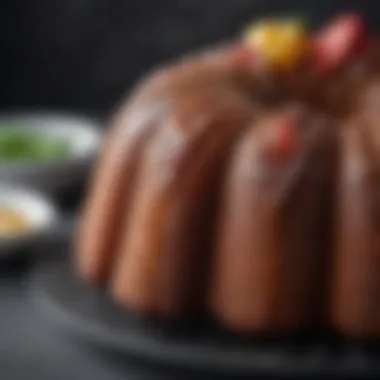

The design of bundt pans is marked by playful innovation and practical considerations. Early versions were substantively basic, mostly made of iron or aluminum. However, as technology in cooking evolved, so did the materials and shapes. For example, the introduction of non-stick coatings enhanced usability by minimizing stuck batter, making for easier bake releases.
Modern bundt pans come in various shapes, sizes, and colors, often reflecting contemporary culinary trends while paying homage to history. Innovations include heavier materials for durability and sturdier bases to facilitate easier handling. Notably, novelty bundt pans are gaining popularity, with designs ranging from floral patterns to seasonal themes. This versatility in bundt pan designs has become part of celebrating occasions like birthdays and holidays, showing the importance of aesthetic in home baking.
Material Considerations
Material considerations are integral when selecting a bundt cake pan. The choice between different materials impacts not only the baking process but also the resulting texture and flavor of the cake. It’s essential to examine how each material influences heat distribution, ease of use, durability, and maintenance.
Metal vs.
Silicone Bundt Pans
When it comes to bundt pans, metal and silicone are the two primary materials to consider. Each has unique characteristics that cater to different baking preferences.
Metal Bundt Pans: Typically made from aluminum or steel, metal pans are known for their robust construction and excellent heat conductivity. They allow for even baking, which is critical when pursuing the ideal cake texture. However, it’s important to ensure that these pans are properly greased before use, as cakes have a tendency to stick. Familiar brands like Nordic Ware and Wilton have long favored metal due to their reliable performance.
Silicone Bundt Pans: In recent years, silicone pans have gained popularity for their flexibility and non-stick qualities. They are lightweight and can easily release cakes without the need for extensive greasing. This feature can be particularly advantageous when baking intricate designs found in novelty bundt pans. Still, one should note silicone’s potential drawback—it spreads heat differently, which might lead to uneven results. Thus, careful attention to baking time and temperature can be crucial.
Nonstick Coatings: Benefits and Drawbacks
Nonstick coatings on bundt pans present a major advantage and should evoke careful consideration. These layers, often made from fluoropolymer and ceramic materials, are engineered to reduce friction and prevent sticking.
Benefits
- Easy Release: The primary benefit of nonstick coatings is that they facilitate a smooth release of your cake. This trait is especially advantageous for bundt cakes with detailed designs.
- Simplified Cleanup: Cleaning nonstick pans tends to be quicker and easier. Many can often be wiped clean, improving efficiency in the kitchen.
Drawbacks
- Durability Concerns: One should be cautious, as nonstick coatings can wear over time or scratch easily. Proper care is essential to prolong the pan's life. For example, using wooden or silicone utensils will avoid damaging the surface.
- Heat Resistance: High temperatures can degrade some nonstick materials. Specific instructions should be adhered to, ensuring that the pan is used within the specified temperature limit.
In summation, understanding material considerations plays a pivotal role in the choice of bundt pans. Each option poses specific advantages and possible limitations, aligning with personal baking styles and preferences. Careful selection can enhance not only your cakes’ outcomes but also your overall baking experience.
Design Variations of Bundt Pans
Design variations of bundt pans are essential, as they significantly influence not only the aesthetics of the cake but also the baking experience. These pans come in various shapes, sizes, and configurations, providing bakers with choices that can cater to specific baking needs and preferences. The choice of pan can affect everything from the cake's cooking time to its overall presentation on the dining table. Understanding these design variations can greatly enhance the baking process, allowing one to create visually appealing and delicious desserts.
Traditional Bundt Cake Pans
Traditional bundt cake pans have a classic circular design with a central tube. This design allows for even baking, as the tube provides additional surface area for heat to circulate. Rubber or silicone materials used in newer versions help to prevent sticking, although metal remains popular. A common size is 10 to 12 cups capacity, which is suitable for many recipes. The pans can feature various decorative indentations, making for stunning final presentations.
Key considerations if using traditional pans:
- Heat Distribution: The use of a solid, heavy material generally ensures even cooking.
- Durability: Metal pans withstand the test of time, though they need proper care.
- Design Variety: Designs may vary, from classic to floral impressions.
These aspects confirm that traditional bundt pans are essential tools in any home baker's kitchen.
Novelty Shapes and Styles
Novelty bundt pans represent a newer trend with creative configurations. These include thematic shapes such as floral, animal, and even holiday designs. While they might add an element of fun to the baking experience, some bakers have concerns over cooking uniformity in these pans. Certain intricate designs may make removing the cake a bit tricky without damaging its shape.
When assessing these novelty options, consider:
- Visual Appeal: Cakes baked in unique shapes can serve as stunning centerpiece desserts.
- Application: More suitable for casual celebrations than formal occasions.
- Flavor Consideration: Intricate pans might require adjustments in the batter for optimal cooking results.
Choosing the right novelty shape can add joy to both baking and presentation, making desserts memorable.
Mini Bundt Pans for Individual Portions
Mini bundt pans emerge as a solution to portion control and aesthetic presentation. They offer a way to craft single servings while keeping the signature bundt design intact. Usually smaller than traditional pans, they cook faster and enable the exploration of various flavors in one baking session. By experimenting with different flavors, a baker can appeal to various tastes at gatherings.
Advantages of mini bundt pans:
- Quick Baking: The reduced size means faster cooking times, activating flavor more quickly.
- Personalization: These pans allow bakers to create a variety of individual servings tailored to each guest's preferences.
- Serving Flexibility: They are easy to serve and make for delightful gifts.
In summary, the design variations of bundt pans are not just about aesthetics. They serve specific functions that can help home bakers achieve their culinary goals while making baking a more enjoyable and creative process.
Benefits of Using Specialty Bundt Cake Pans
In home baking, selecting the right tools is crucial for success. Specialty bundt cake pans offer several advantages that enhance the baking experience. Understanding these benefits can improve both the aesthetics and taste of your desserts.
Enhanced Presentation and Aesthetics
Using a specialty bundt cake pan elevates the visual appeal of the dessert. The unique shapes and intricate designs create a more attractive presentation. When properly baked, the cake releases easily, revealing beautiful patterns. This can impress guests and elevate any gathering. Consider using a sculpted pan for themed occasions, like holidays or birthdays. They instantly turn simple cakes into stunning centerpieces.
"The appearance of a dish often enhances its perceived taste in the eyes of the diners."
Additionally, specialty pans come in various materials and finishes that cater to different styles. While some might prefer the elegance of a shiny metal finish, others may opt for a rustic look provided by matte or coated pans. This variety allows bakers to pick a bundt pan that aligns with their personal aesthetic and the event's mood.
Consistent Baking Results
One of the key reasons home bakers choose specialty bundt pans is the consistency they offer in baking results. The thickness and shape of these pans distribute heat evenly during the baking process. This reduces the risk of overcooking or having unevenly baked areas. With a reliable bundt pan, the cusp of creativity becomes empirical.
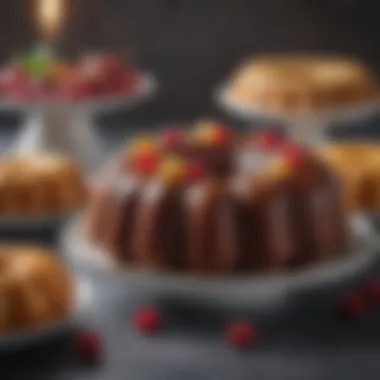
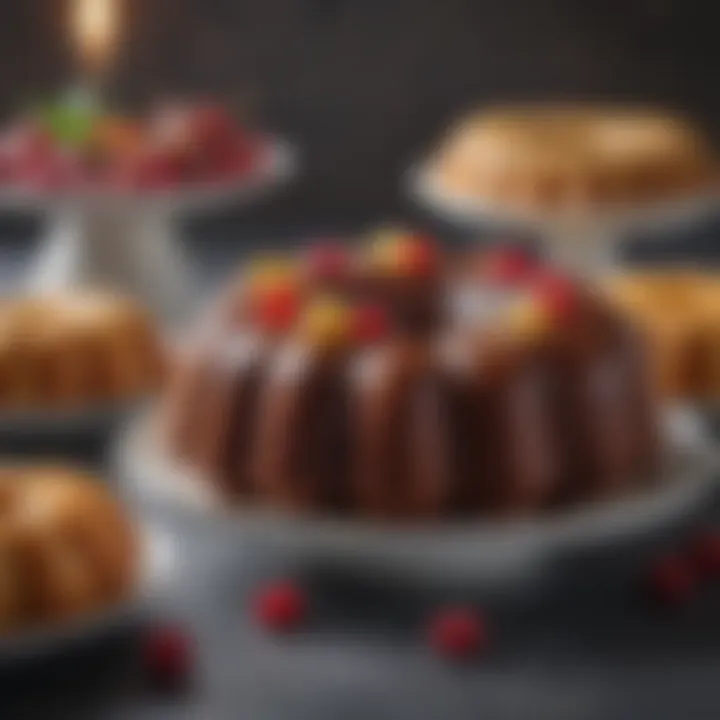
Tasking bakers with integrating almost any cake recipe inside a bundt pan becomes practical. Consider traditional recipes like the classic vanilla or rich chocolate marble bundt cakes.
When regular cake pans might require further adjustments to recipe timings or oven temperatures, specialty bundt pans enable a more straightforward approach. Many bakers find they can deliver the same big flavor every time despite the type of batter used. With every handful of drop, the specialty bundt cake pans maintain identity and performance, reducing kitchen stress.
In summary, specialty bundt cake pans are valuable tools in every baker's arsenal. They invite both artistry and reliable results, which significantly enhance the overall baking and dining experience.
Choosing the Right Bundt Pan
Choosing the right bundt pan is crucial for any baking enthusiast. The type of pan selected can directly affect baking times, textures, and presentation of your cakes. A well-chosen bundt pan ensures that your cake rises properly, holds its shape, and comes out easily after baking. Knowing what to look for in regards to size, material, and design can assist in making an informed decisions that will enhance your baking experience. As such, understanding these specific elements, benefits, and considerations will enlighten the selection process.
Factors to Consider When Purchasing
When selecting a bundt pan, there are several factors to consider:
- Material: Bundt pans are generally made from metal or silicone. Metal pans offer superior heat conductivity, while silicone pans provide easy release principles. Each material has its strengths.
- Size: Bundt pans come in a range of sizes, typically from 6 to 12 cups or more. The size chosen should correspond with the cake recipe to ensure proper baking.
- Weight and Durability: Heavier pans tend to heat evenly and maintain their shape. Lightweight pans may warp over time under high heat. A great investment would be a durable, heavyweight pan for lasting results.
- Design: The intricate designs of some bundt pans can make all the difference in presentation. If visual appeal is a prime concern, consider a women’s designer integrated bowl like Nordic Ware’s Classic, offering unique finishes.
Moreover, always consider the handle design. Various models provide a better grip when transferring to and from the oven.
Top Brands Reviewed
Selecting a well-regarded brand can simplify the purchase process. Renowned brands in the world of bundt baking include:
- Nordic Ware: Known for their quality and variety, Nordic Ware bundt pans often lead the industry. The Classic Bundt pan is highly acclaimed for its reliable performance and easy release.
- Wilton: This brand is frequently recommended for beginner bakers. They have durable nonstick options that come at an accessible price point.
- Paderno: Their heavyweight pans are built for longevity, making them a staple in serious bakers' kitchens.
- Silicone Zone: They specialize in silicone pans that are flexible yet stable. These are great for ensuring easy cake removals.
In the end, the best choice will depend highly on personal needs and baking goals. Careful assessment of the design, material, and suitability can significantly improve home baking outcomes.
While purchasing the best bundt pan, prioritize functionality and ease of use. Never compromise on the durability.
Care and Maintenance of Bundt Pans
Caring for specialty bundt pans is essential for maintaining their longevity and ensuring superior baking outcomes. A well-maintained pan allows for optimal heat distribution, promoting even cooking. Moreover, understanding maintenance routines solidifies the investment made in these varied pans, ultimately enhancing your baking experience.
Cleaning Techniques
Cleaning your bundt pans properly is integral to their success in the kitchen. First step is to allow the pan to cool after baking. Placing a hot pan under cold water can warp its shape. Use warm soapy water and a gentle sponge or cloth. Avoid abrasive materials, as they can scratch the surface and lead to a decrease in baking quality.
Here are some effective cleaning tips:
- Hand wash the pans when possible—most are not designed for the dishwasher.
- Thoroughly dry the pan after cleaning to prevent moisture from damaging the pan material.
- For stubborn residue, immerse the pan in warm soapy water for about 15 minutes.
Some specialty pans come with unique, intricate designs. In these cases, gently buzzing a soft brush along crevices can help dislodge any lingering batter.
Preventing Stickiness and Damage
Preventing stickiness is just as vital as cleaning. An effective application of grease reduces the risk of cakes adhering to the pan. Here are some strategies for optimal results:
- Choose the right grease. Use options like butter, oil, or even cooking spray specifically suited for bundt pans.
- Dusting with flour after greasing is an effective method. This additional step ensures that the batter does not stick to the pan’s crust.
- Pay attention to baking time to prevent overcooking, which can lead to cakes being dense and harder to remove.
Another consideration is storage. Stack bundt pans carefully, nesting them when needed with protective padding to avoid scratches. Store in a cool, dry place, away from direct sunlight. This approach helps safeguard against warping and other forms of damage.
Always remember that with proper care, your specialty bundt pans can deliver countless delicious cakes while ensuring a seamless baking process.
Innovative Baking Techniques
Innovative baking techniques play a significant role in enhancing the experience of using specialty Bundt cake pans. They allow bakers to push the boundaries of traditional recipes, resulting in impressive and flavorful desserts. By employing these techniques, one can achieve not only richer tastes but also unique presentations. Knowing these methods can transform your approach to baking, making it more creative and enjoyable.
Layering Flavors in Bundt Cakes
Layering flavors is an effective way to elevate a basic Bundt cake into something extraordinary. This technique involves mixing different flavors into your cake batter, ensuring a delightful burst of taste in every slice. To achieve this, bakers often combine complementary flavors, such as chocolate and hazelnut or vanilla and almond.
Here are some key considerations when layering flavors:
- Base Flavor: Start with a primary flavor that can set the tone for the cake.
- Contrast: Introduce a contrasting element, like spices or fruit purées, to awaken the palate.
- Extraction: Use extracts judiciously to maintain balance among the flavors. Too much can overwhelm the base cake.
- Balance in Portions: Layered batters can be gently swirled or alternated during baking for completion, instead of over-mixing which could result in flat flavors.
Both herbs and spices can create an unexpected and delightful experience. Consider incorporating fresh citrus zests or finely chopped herbs to enhance depth.
Creative Fillings and Frostings
Adding fillings and frostings is where one can truly unleash creativity with specialty Bundt cake pans. Beyond the batter itself, unique additions can substantively impact flavor and appearance.
Fillings
A variety of fillings can provide moisture and excitement to the cake. Here are a few types to experiment with:
- Fruit Compote: A layer of fruit compote in the middle of a cake adds sweetness and tanginess.
- Ganache: Chocolate ganache offers richness and indulgence when used as a filling.
- Cream Cheese Mixtures: A cream cheese filling brings sweetness and creamy texture.
Frostings
Frostings cover the exterior leaving a lasting impression. Explore these options:
- Glazes: Lighter and more liquid than traditional frostings, glazes can penetrate cakes profoundly, adding flavor.
- Buttercream: Known for creamy consistency and customizable flavors, buttercream works well on second layer in construction.
- Royal Icing: Ideal for decorations without adding too much weight to the overall cake composition.
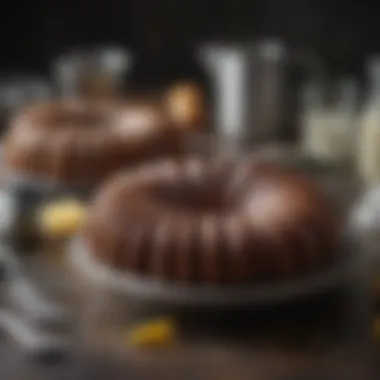
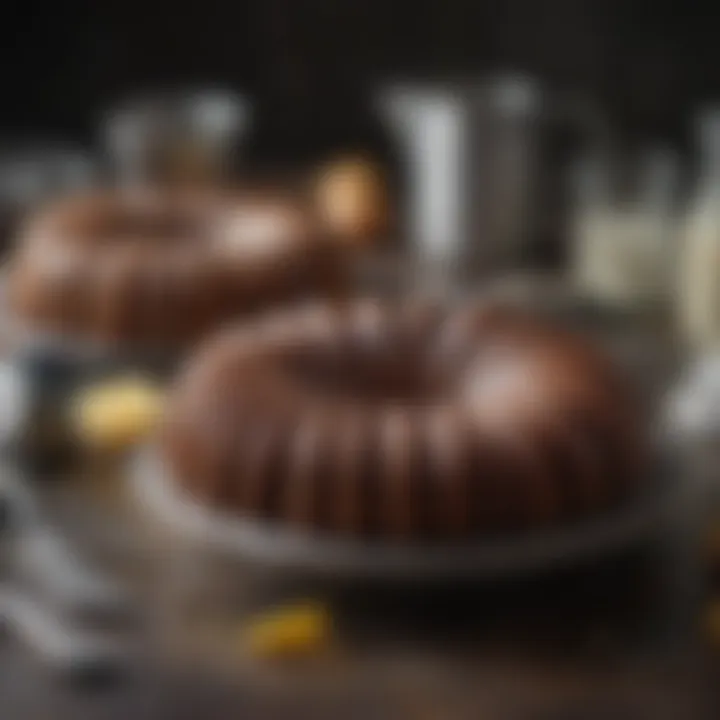
Understanding and practicing these innovative techniques can make your Bundt cakes stand out. Utilizing flavors and textures in complementary ways warrants endless possibilities.
By employing innovative baking techniques, you can create cakes that are delightful on both taste buds and display, enhancing the overall baking experience.
Popular Bundt Cake Recipes
Bundt cakes serve as timeless desserts, effortlessly combining aesthetic appeal with scrumptious flavor. In this sectio, we examine a selection of top recipes that highlight the versatility and charm of specialty bundt cake pans. Popular bundt cake recipes are crucial not only because they demonstrate the unique capabilities of these pans but also because they inspire creativity in one's baking endeavors. With various flavors and fillings, each destinct recipe stands as an opportunity for both novice and seasoned bakers to explore nuanced culinary techniques and crafting methods that culminate in delightful experiences.
Classic Vanilla Bundt Cake
The Classic Vanilla Bundt Cake holds a place of prominonce in the pantheon of bundt recipes. Its simplicity allows the flavors to shine through, making it a staple in many kitchens. The weighty cake, characterized by its delightful moistness, provides an excellent canvas for additional flavors, glazes, or toppings. This recipe benefits from high-quality vanilla extract, as the flavor profile deepens with the right choice of ingredients.
Ingredients:
- 2 3/4 cups all-purpose flour
- 1 tablespoon baking powder
- 1/2 teaspoon salt
- 1 cup unsalted butter, softened
- 2 cups granulated sugar
- 4 large eggs
- 1 tablespoon vanilla extract
- 1 cup buttermilk
Instructions:
- Preheat the oven to 350°F (175°C).
- Grease and flour the bundt pan to prevent sticking.
- In a medium bowl, whisk together flour, baking powder, and salt.
- In another bowl, cream butter and sugar until light and fluffy.
- Add eggs, one at a time, mixing well after each. Stir in vanilla.
- Alternate adding the dry ingredients and buttermilk to the butter mixture, beginning and ending with dry ingredients.
- Pour the batter into the prepared bundt pan and smooth the top.
- Bake for 50-60 minutes or until a toothpick comes out clean.
- Allow to cool, and then invert onto a serving plate.
This classic recipe can be easily customized. A sprinkling of powdered sugar or a light glaze adds a touch of elegance while enhancing flavor.
Chocolate Marble Bundt Cake
The Chocolate Marble Bundt Cake offers a delightful fusion of flavors that meld the rich essence of chocolate with the classic softness of vanilla. It is especially popular at gatherings where USDA regulatory compliance is not a concern. The unique marbling effect creates a visually striking appearance for dessert tables.
Ingredients:
- 2 cups all-purpose flour
- 1 cup cocoa powder
- 1 1/2 teaspoons baking powder
- 1 teaspoon baking soda
- 1/2 teaspoon salt
- 1 cup unsalted butter, softened
- 2 cups granulated sugar
- 4 large eggs
- 1 teaspoon vanilla extract
- 1 cup buttermilk
Instructions:
- Preheat your oven to 350°F (175°C).
- Grease and flour your bundt cake pan thoroughly to ensure easy release.
- In a mixing bowl, combine flour, cocoa powder, baking powder, baking soda, and salt. Set aside.
- Cream butter and sugar until fluffy in a separate bowl. Add eggs one by one, ensuring they are fully added.
- Mix in vanilla extract.
- Stir in flour mixture in alternating batches with buttermilk.
- Reserve one-third of the batter, and mix in additional cocoa powder to it.
- Alternately drop spoonfuls of the vanilla and chocolate batters into the bundt pan, swirling slightly to create the marble effect.
- Bake for 60 minutes or until fully cooked through.
This cake excels when served plain, but it pairs wonderfully with chocolate ganache or whipped cream as well.
Lemon Poppy Seed Bundt Cake
Lemon Poppy Seed Bundt Cake introduces a zesty flavor profile, moving away from richer sweets typical for bundt cakes. Perfect for summer gatherings or brunch events, this cake celebrates freshness and offers a contrast to denser options available. The combination of tart lemon and nutrient-rich poppy seeds invigorates the palate.
Ingredients:
- 2 cups all-purpose flour
- 2 teaspoons baking powder
- 1/2 teaspoon salt
- 1 cup unsalted butter, softened
- 2 cups granulated sugar
- 4 large eggs
- 1 tablespoon lemon zest
- 1/4 cup fresh lemon juice
- 1/2 cup buttermilk
- 2 tablespoons poppy seeds
Instructions:
- Preheat the oven to 350°F (175°C).
- Prepare bundt pan with grease and flour.
- In a bowl, mix flour, baking powder, and salt. Set aside.
- In a larger bowl, cream butter and sugar until light. Incorporate eggs one at a time.
- Gradually add in the lemon juice and zest, till mixture combined.
- Mix in dry ingredients alternately with buttermilk, folding in poppy seeds last.
- Pour into bundt pan and bake for 45-50 minutes.
Each of these recipes symbolizes the kitchens's tradition of healthy, home-cooked delights, presenting such potential bonded with simplicity. The ability to use a bundt pan ensures every cake is impressive to both sight and taste.
Bundt cakes offer divine possibilities when it comes to presentations and flavor mixing that elevate any baking experience. Even these sleightly different cakes spark an enduring connection between domestic joys and love for food.
Alternative Uses for Bundt Pans
Alternative uses for bundt pans offer much more functionality than only making cakes. These well-designed pans serve a dual purpose: providing whimsical designs and enhancing presentation skills while also accommodating a variety of savory and auxiliary tasks in the kitchen. Recognizing these alternative applications can encourage improved creativity in meal preparation and presentation, especially for those looking to expand their culinary repertoire.
Savory Dishes: Beyond Desserts
Bundt pans transcend the boundaries of baking sweet treats. They provide a unique format for creating savory dishes as well. One way to achieve a visually appealing entrée or side is by using a bundt pan to create dishes like meatloaf or lasagna. This approach ensures even cooking, as the pan’s distinctive shape allows heat to circulate more thoroughly. Here are key ideas for savory uses:
- Meatloaf: Mixing up ground meat with spices, veggies, and breadcrumbs, then pouring it into the pan creates a visually compelling meatloaf sibling.
- Vegetable Risotto: Layering arborio rice, broth, and vegetables can yield a delectable and attractive risotto dish when removed from the pan.
- Savory Cake: A garlic and herb cheese bread or biscuit can also emerge as a savory cake when made in a bundt pan, captivating both texture and aesthetic appeal.
These savory options not only deliver delectable flavors but also contribute zestful presentations for lunch gatherings or even casual family dinners. Adopting this kind of versatility makes products more useful all around.
Bundt Pans for Unique Presentations
The bundt pans, with their intricate and elegant designs, can revolutionize how meals are served. Whether it's a cake that looks like it has jumped off a menu, or a savory dish drawing attention, they tend to spark conversation around the dining table. Here are some ideas for unique presentations that seize attention:
- Layered Salads: Using a bundt pan facilitates the artful layering of various ingredients, from greens to roasted items delivering a sensory feast.
- Cheese and Chutney: A cheese and cracker platter can engage diners when stacked stylishly going upwards in a bundt form.
- Festive Nibbles: Fruit salades or sweet antipastos served upside-down for party purposes can delight guests, factoring in a surprising treat.
Unique presentations elevate the dining experience, transforming ordinary meals into memorable events.
Ultimately, exploring alternative uses for bundt pans extends well beyond traditional baking -- it cultivates creativity and brings graphical flair to multiple aspects of home cooking. With the broad capabilities of these versatile kitchen tools, achieving dramatic table settings can become a routine delight rather than an occasional surprise.
Epilogue
In this exploration of specialty bundt cake pans, it is important to emphasize their role not just as tools, but as instruments facilitating creativity in baking. Choosing the right bundt pan can vastly enhance both the presentation and taste of a dish. Factors like material type, design variations, and user preference all come into play.
The unique shapes and designs of specialty bundt pans can transform even the simplest of cakes into visually appealing masterpieces. A well-chosen pan adds dimensionality and flair, which is particularly appealing for gatherings and celebrations.
Also essential is the significance of properly maintaining these pans to prolong their lifespan. Regular cleaning and careful handling can prevent sticking and other issues that would otherwise hinder baking.
A well-maintained bundt pan can last for years, enhancing your baking journey mile after mile.
An array of creative options exists when utilizing these pans not only for cakes but also for various savory dishes. This versatility is a definite advantage for home cooks looking to explore new culinary experiments.
Ultimately, specialty bundt cake pans empower bakers with the ability to present their creations elegantly while embracing innovative techniques. The considerate exploration of their offerings allows cooks, from novices to experts, to unlock their potential in the kitchen. Therefore, investing time to understand specialty bundt cake pans can yield rewarding results, leading to greater success in your baking endeavors.







